Exploring International Business Environment: Bolivia 2034 Scenario
VerifiedAdded on 2022/08/27
|8
|1560
|22
Project
AI Summary
This project presents a scenario planning exercise focused on Bolivia in the year 2034, exploring the interplay of various factors influencing the country's international business environment. The analysis begins by outlining key events from 2019 to 2031, including the resignation of President Morales, privatization efforts, natural disasters (earthquakes, volcano, forest fires, floods, and landslides), and the increasing global demand for lithium, culminating in a US-China trade war. These events are then used to construct a narrative leading to the end-state in 2034, characterized by kleptocracy, economic instability, increased crime, social inequalities, and environmental degradation. The project identifies the core causes, such as political instability and environmental disasters, and their implications, including poor infrastructure, poverty, hunger, and conflicts. The project concludes with recommendations for addressing these issues, emphasizing the need for Bolivia to tackle the root causes of its political, demographic, social, and economic challenges to improve its future.
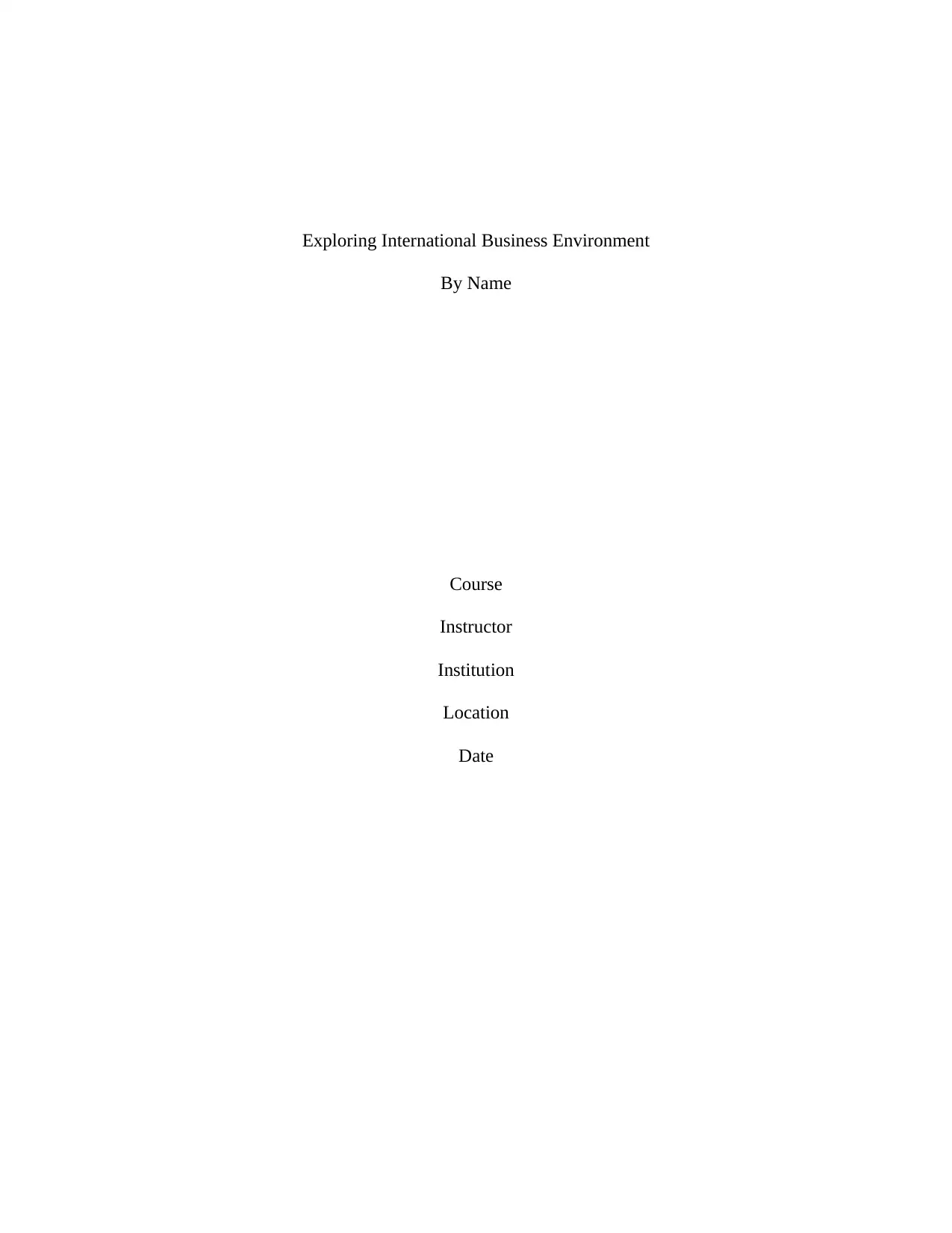
Exploring International Business Environment
By Name
Course
Instructor
Institution
Location
Date
By Name
Course
Instructor
Institution
Location
Date
Paraphrase This Document
Need a fresh take? Get an instant paraphrase of this document with our AI Paraphraser
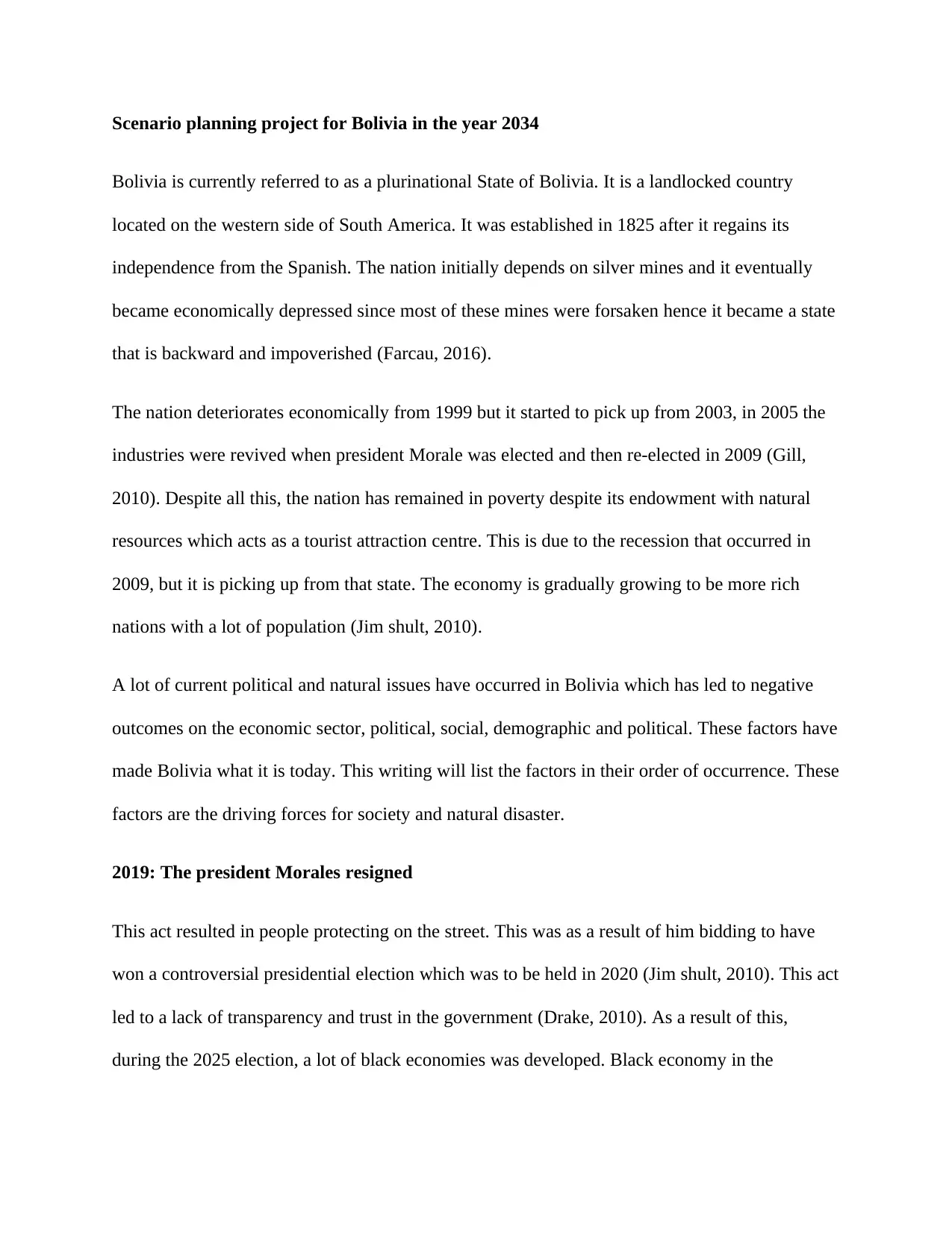
Scenario planning project for Bolivia in the year 2034
Bolivia is currently referred to as a plurinational State of Bolivia. It is a landlocked country
located on the western side of South America. It was established in 1825 after it regains its
independence from the Spanish. The nation initially depends on silver mines and it eventually
became economically depressed since most of these mines were forsaken hence it became a state
that is backward and impoverished (Farcau, 2016).
The nation deteriorates economically from 1999 but it started to pick up from 2003, in 2005 the
industries were revived when president Morale was elected and then re-elected in 2009 (Gill,
2010). Despite all this, the nation has remained in poverty despite its endowment with natural
resources which acts as a tourist attraction centre. This is due to the recession that occurred in
2009, but it is picking up from that state. The economy is gradually growing to be more rich
nations with a lot of population (Jim shult, 2010).
A lot of current political and natural issues have occurred in Bolivia which has led to negative
outcomes on the economic sector, political, social, demographic and political. These factors have
made Bolivia what it is today. This writing will list the factors in their order of occurrence. These
factors are the driving forces for society and natural disaster.
2019: The president Morales resigned
This act resulted in people protecting on the street. This was as a result of him bidding to have
won a controversial presidential election which was to be held in 2020 (Jim shult, 2010). This act
led to a lack of transparency and trust in the government (Drake, 2010). As a result of this,
during the 2025 election, a lot of black economies was developed. Black economy in the
Bolivia is currently referred to as a plurinational State of Bolivia. It is a landlocked country
located on the western side of South America. It was established in 1825 after it regains its
independence from the Spanish. The nation initially depends on silver mines and it eventually
became economically depressed since most of these mines were forsaken hence it became a state
that is backward and impoverished (Farcau, 2016).
The nation deteriorates economically from 1999 but it started to pick up from 2003, in 2005 the
industries were revived when president Morale was elected and then re-elected in 2009 (Gill,
2010). Despite all this, the nation has remained in poverty despite its endowment with natural
resources which acts as a tourist attraction centre. This is due to the recession that occurred in
2009, but it is picking up from that state. The economy is gradually growing to be more rich
nations with a lot of population (Jim shult, 2010).
A lot of current political and natural issues have occurred in Bolivia which has led to negative
outcomes on the economic sector, political, social, demographic and political. These factors have
made Bolivia what it is today. This writing will list the factors in their order of occurrence. These
factors are the driving forces for society and natural disaster.
2019: The president Morales resigned
This act resulted in people protecting on the street. This was as a result of him bidding to have
won a controversial presidential election which was to be held in 2020 (Jim shult, 2010). This act
led to a lack of transparency and trust in the government (Drake, 2010). As a result of this,
during the 2025 election, a lot of black economies was developed. Black economy in the
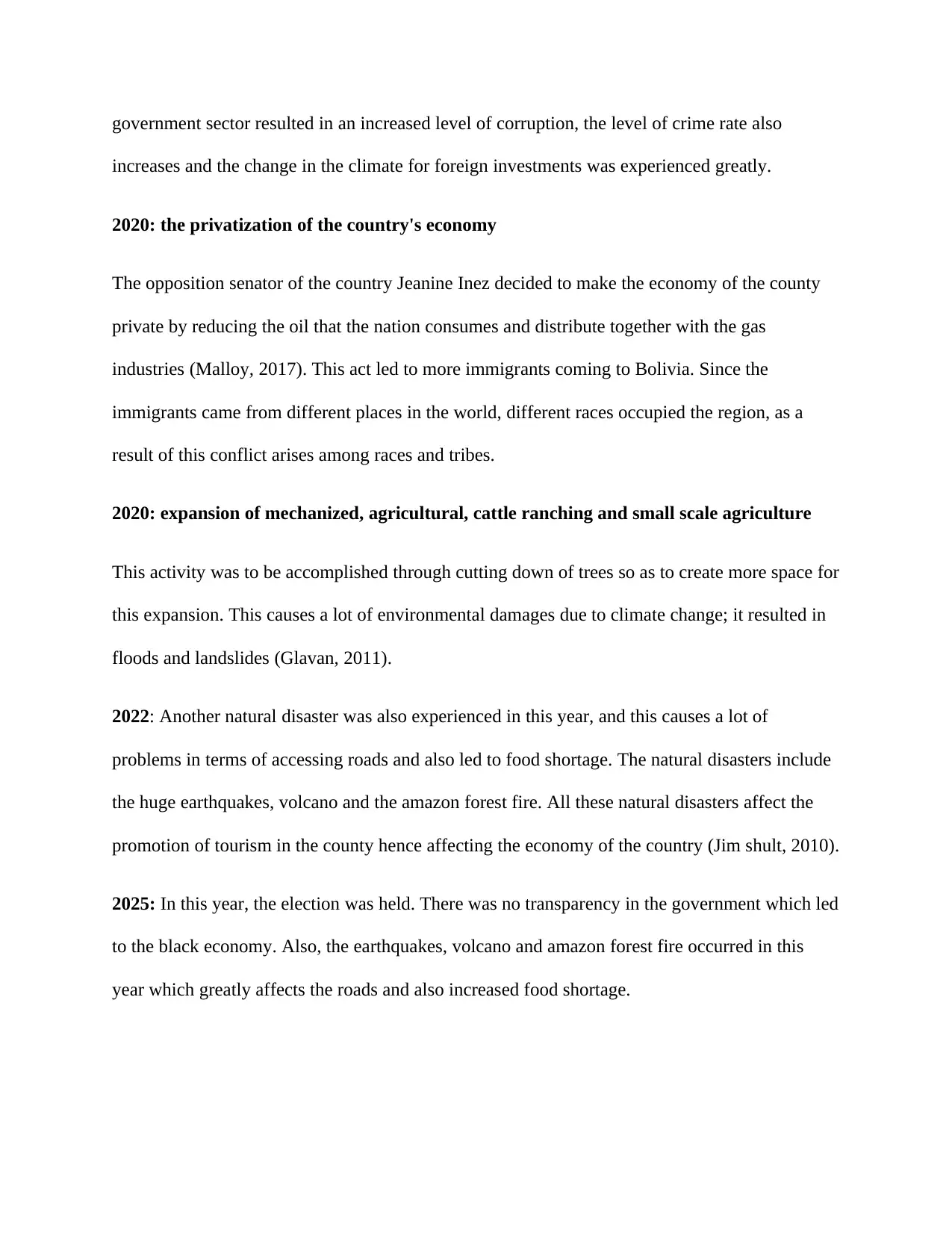
government sector resulted in an increased level of corruption, the level of crime rate also
increases and the change in the climate for foreign investments was experienced greatly.
2020: the privatization of the country's economy
The opposition senator of the country Jeanine Inez decided to make the economy of the county
private by reducing the oil that the nation consumes and distribute together with the gas
industries (Malloy, 2017). This act led to more immigrants coming to Bolivia. Since the
immigrants came from different places in the world, different races occupied the region, as a
result of this conflict arises among races and tribes.
2020: expansion of mechanized, agricultural, cattle ranching and small scale agriculture
This activity was to be accomplished through cutting down of trees so as to create more space for
this expansion. This causes a lot of environmental damages due to climate change; it resulted in
floods and landslides (Glavan, 2011).
2022: Another natural disaster was also experienced in this year, and this causes a lot of
problems in terms of accessing roads and also led to food shortage. The natural disasters include
the huge earthquakes, volcano and the amazon forest fire. All these natural disasters affect the
promotion of tourism in the county hence affecting the economy of the country (Jim shult, 2010).
2025: In this year, the election was held. There was no transparency in the government which led
to the black economy. Also, the earthquakes, volcano and amazon forest fire occurred in this
year which greatly affects the roads and also increased food shortage.
increases and the change in the climate for foreign investments was experienced greatly.
2020: the privatization of the country's economy
The opposition senator of the country Jeanine Inez decided to make the economy of the county
private by reducing the oil that the nation consumes and distribute together with the gas
industries (Malloy, 2017). This act led to more immigrants coming to Bolivia. Since the
immigrants came from different places in the world, different races occupied the region, as a
result of this conflict arises among races and tribes.
2020: expansion of mechanized, agricultural, cattle ranching and small scale agriculture
This activity was to be accomplished through cutting down of trees so as to create more space for
this expansion. This causes a lot of environmental damages due to climate change; it resulted in
floods and landslides (Glavan, 2011).
2022: Another natural disaster was also experienced in this year, and this causes a lot of
problems in terms of accessing roads and also led to food shortage. The natural disasters include
the huge earthquakes, volcano and the amazon forest fire. All these natural disasters affect the
promotion of tourism in the county hence affecting the economy of the country (Jim shult, 2010).
2025: In this year, the election was held. There was no transparency in the government which led
to the black economy. Also, the earthquakes, volcano and amazon forest fire occurred in this
year which greatly affects the roads and also increased food shortage.
⊘ This is a preview!⊘
Do you want full access?
Subscribe today to unlock all pages.

Trusted by 1+ million students worldwide
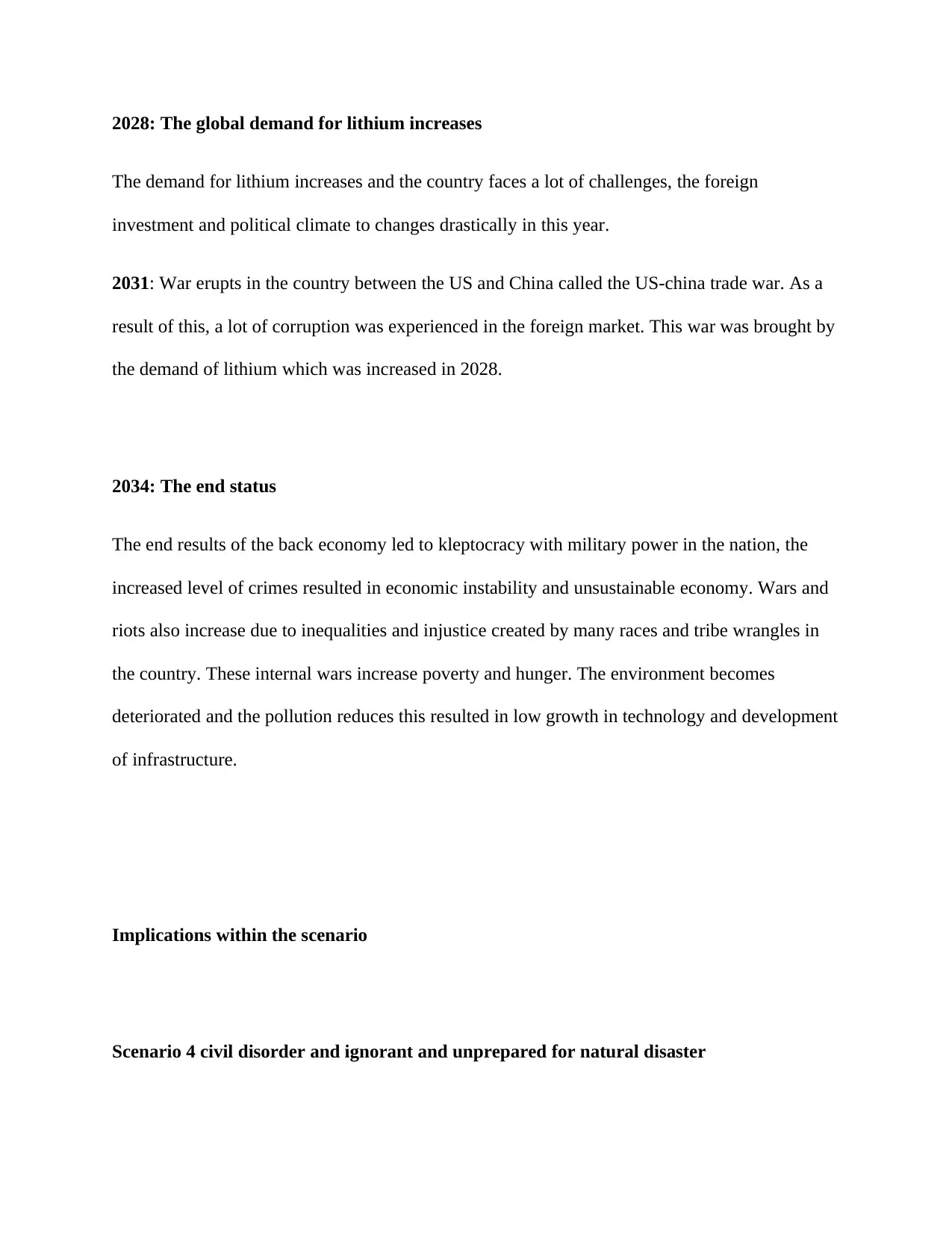
2028: The global demand for lithium increases
The demand for lithium increases and the country faces a lot of challenges, the foreign
investment and political climate to changes drastically in this year.
2031: War erupts in the country between the US and China called the US-china trade war. As a
result of this, a lot of corruption was experienced in the foreign market. This war was brought by
the demand of lithium which was increased in 2028.
2034: The end status
The end results of the back economy led to kleptocracy with military power in the nation, the
increased level of crimes resulted in economic instability and unsustainable economy. Wars and
riots also increase due to inequalities and injustice created by many races and tribe wrangles in
the country. These internal wars increase poverty and hunger. The environment becomes
deteriorated and the pollution reduces this resulted in low growth in technology and development
of infrastructure.
Implications within the scenario
Scenario 4 civil disorder and ignorant and unprepared for natural disaster
The demand for lithium increases and the country faces a lot of challenges, the foreign
investment and political climate to changes drastically in this year.
2031: War erupts in the country between the US and China called the US-china trade war. As a
result of this, a lot of corruption was experienced in the foreign market. This war was brought by
the demand of lithium which was increased in 2028.
2034: The end status
The end results of the back economy led to kleptocracy with military power in the nation, the
increased level of crimes resulted in economic instability and unsustainable economy. Wars and
riots also increase due to inequalities and injustice created by many races and tribe wrangles in
the country. These internal wars increase poverty and hunger. The environment becomes
deteriorated and the pollution reduces this resulted in low growth in technology and development
of infrastructure.
Implications within the scenario
Scenario 4 civil disorder and ignorant and unprepared for natural disaster
Paraphrase This Document
Need a fresh take? Get an instant paraphrase of this document with our AI Paraphraser
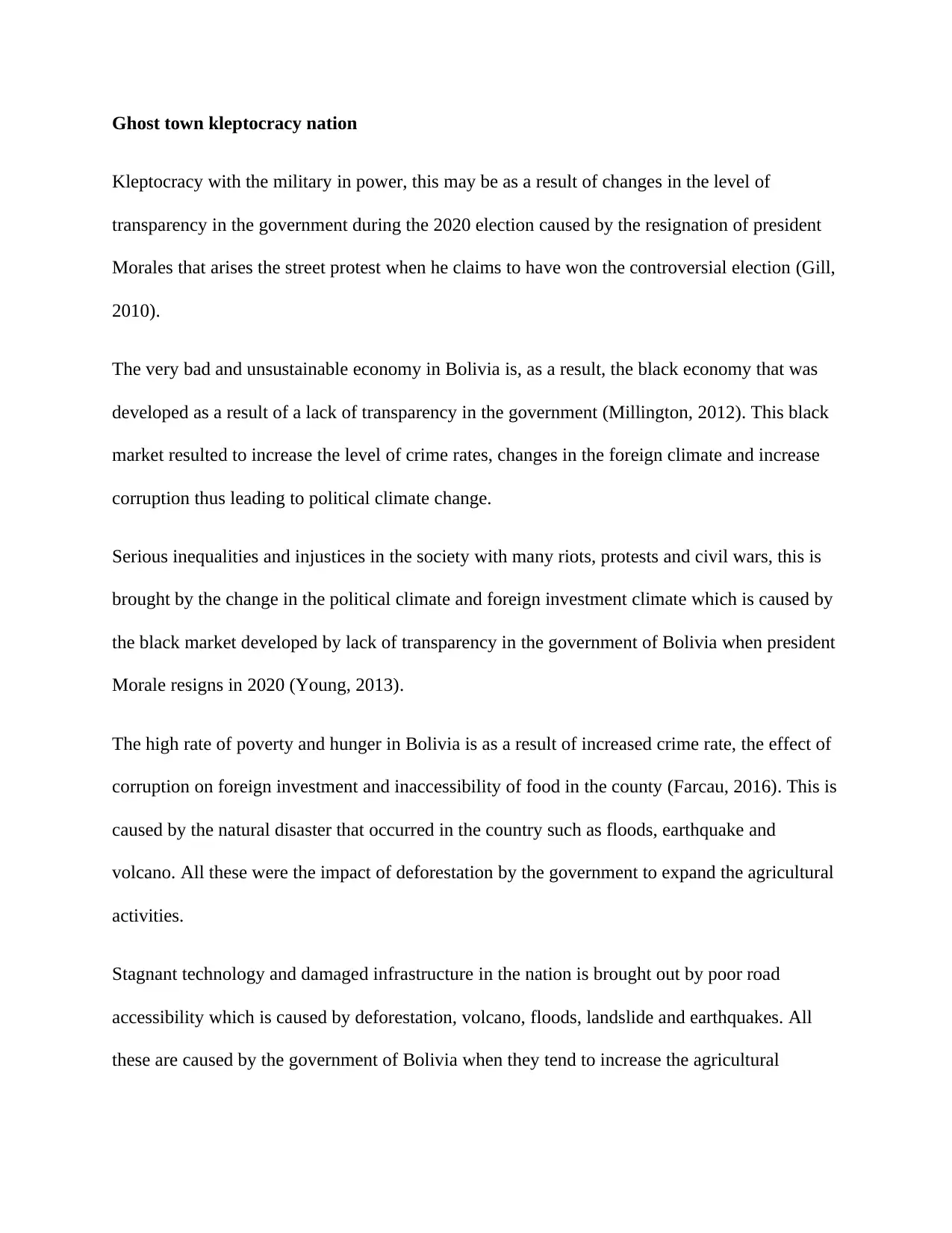
Ghost town kleptocracy nation
Kleptocracy with the military in power, this may be as a result of changes in the level of
transparency in the government during the 2020 election caused by the resignation of president
Morales that arises the street protest when he claims to have won the controversial election (Gill,
2010).
The very bad and unsustainable economy in Bolivia is, as a result, the black economy that was
developed as a result of a lack of transparency in the government (Millington, 2012). This black
market resulted to increase the level of crime rates, changes in the foreign climate and increase
corruption thus leading to political climate change.
Serious inequalities and injustices in the society with many riots, protests and civil wars, this is
brought by the change in the political climate and foreign investment climate which is caused by
the black market developed by lack of transparency in the government of Bolivia when president
Morale resigns in 2020 (Young, 2013).
The high rate of poverty and hunger in Bolivia is as a result of increased crime rate, the effect of
corruption on foreign investment and inaccessibility of food in the county (Farcau, 2016). This is
caused by the natural disaster that occurred in the country such as floods, earthquake and
volcano. All these were the impact of deforestation by the government to expand the agricultural
activities.
Stagnant technology and damaged infrastructure in the nation is brought out by poor road
accessibility which is caused by deforestation, volcano, floods, landslide and earthquakes. All
these are caused by the government of Bolivia when they tend to increase the agricultural
Kleptocracy with the military in power, this may be as a result of changes in the level of
transparency in the government during the 2020 election caused by the resignation of president
Morales that arises the street protest when he claims to have won the controversial election (Gill,
2010).
The very bad and unsustainable economy in Bolivia is, as a result, the black economy that was
developed as a result of a lack of transparency in the government (Millington, 2012). This black
market resulted to increase the level of crime rates, changes in the foreign climate and increase
corruption thus leading to political climate change.
Serious inequalities and injustices in the society with many riots, protests and civil wars, this is
brought by the change in the political climate and foreign investment climate which is caused by
the black market developed by lack of transparency in the government of Bolivia when president
Morale resigns in 2020 (Young, 2013).
The high rate of poverty and hunger in Bolivia is as a result of increased crime rate, the effect of
corruption on foreign investment and inaccessibility of food in the county (Farcau, 2016). This is
caused by the natural disaster that occurred in the country such as floods, earthquake and
volcano. All these were the impact of deforestation by the government to expand the agricultural
activities.
Stagnant technology and damaged infrastructure in the nation is brought out by poor road
accessibility which is caused by deforestation, volcano, floods, landslide and earthquakes. All
these are caused by the government of Bolivia when they tend to increase the agricultural
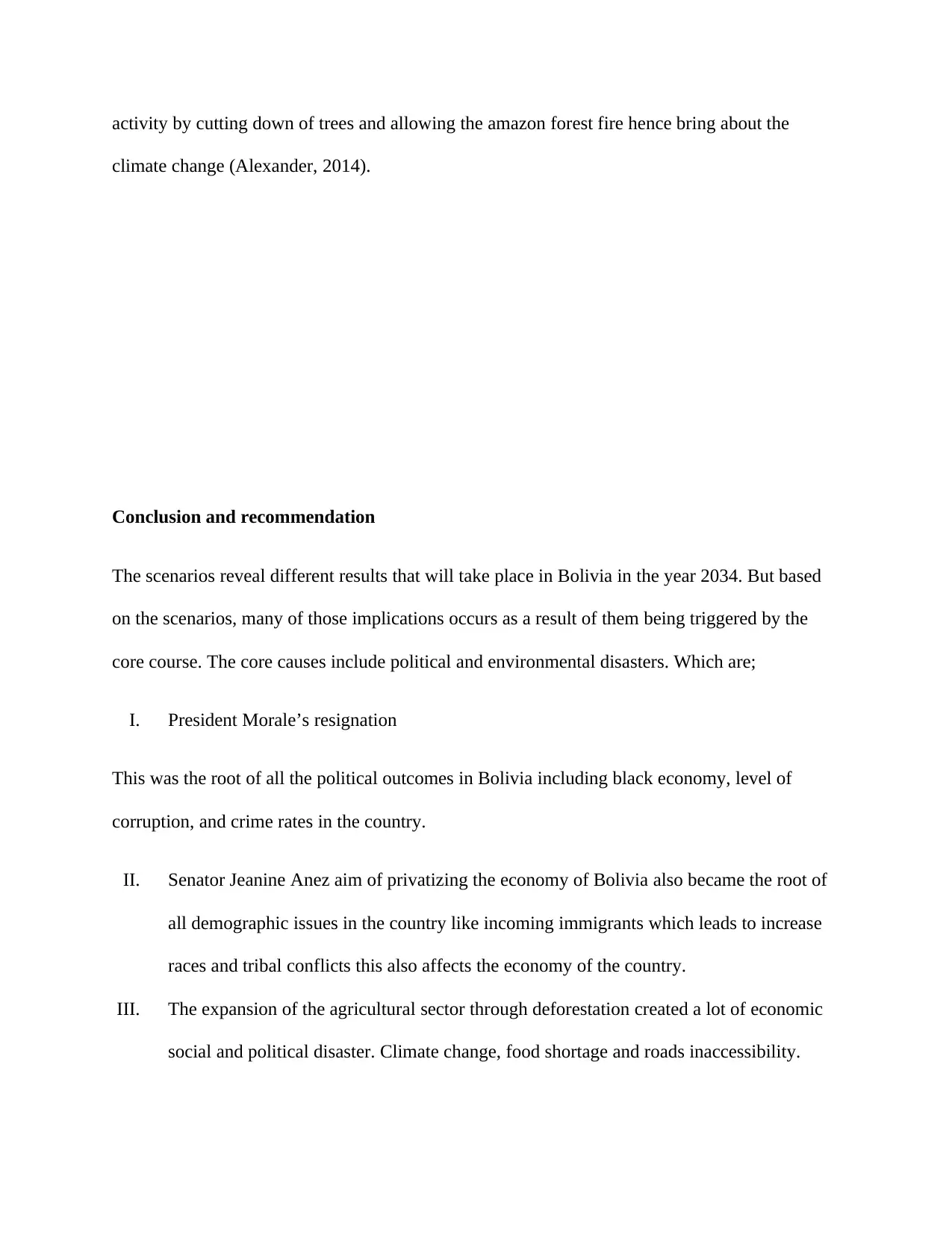
activity by cutting down of trees and allowing the amazon forest fire hence bring about the
climate change (Alexander, 2014).
Conclusion and recommendation
The scenarios reveal different results that will take place in Bolivia in the year 2034. But based
on the scenarios, many of those implications occurs as a result of them being triggered by the
core course. The core causes include political and environmental disasters. Which are;
I. President Morale’s resignation
This was the root of all the political outcomes in Bolivia including black economy, level of
corruption, and crime rates in the country.
II. Senator Jeanine Anez aim of privatizing the economy of Bolivia also became the root of
all demographic issues in the country like incoming immigrants which leads to increase
races and tribal conflicts this also affects the economy of the country.
III. The expansion of the agricultural sector through deforestation created a lot of economic
social and political disaster. Climate change, food shortage and roads inaccessibility.
climate change (Alexander, 2014).
Conclusion and recommendation
The scenarios reveal different results that will take place in Bolivia in the year 2034. But based
on the scenarios, many of those implications occurs as a result of them being triggered by the
core course. The core causes include political and environmental disasters. Which are;
I. President Morale’s resignation
This was the root of all the political outcomes in Bolivia including black economy, level of
corruption, and crime rates in the country.
II. Senator Jeanine Anez aim of privatizing the economy of Bolivia also became the root of
all demographic issues in the country like incoming immigrants which leads to increase
races and tribal conflicts this also affects the economy of the country.
III. The expansion of the agricultural sector through deforestation created a lot of economic
social and political disaster. Climate change, food shortage and roads inaccessibility.
⊘ This is a preview!⊘
Do you want full access?
Subscribe today to unlock all pages.

Trusted by 1+ million students worldwide
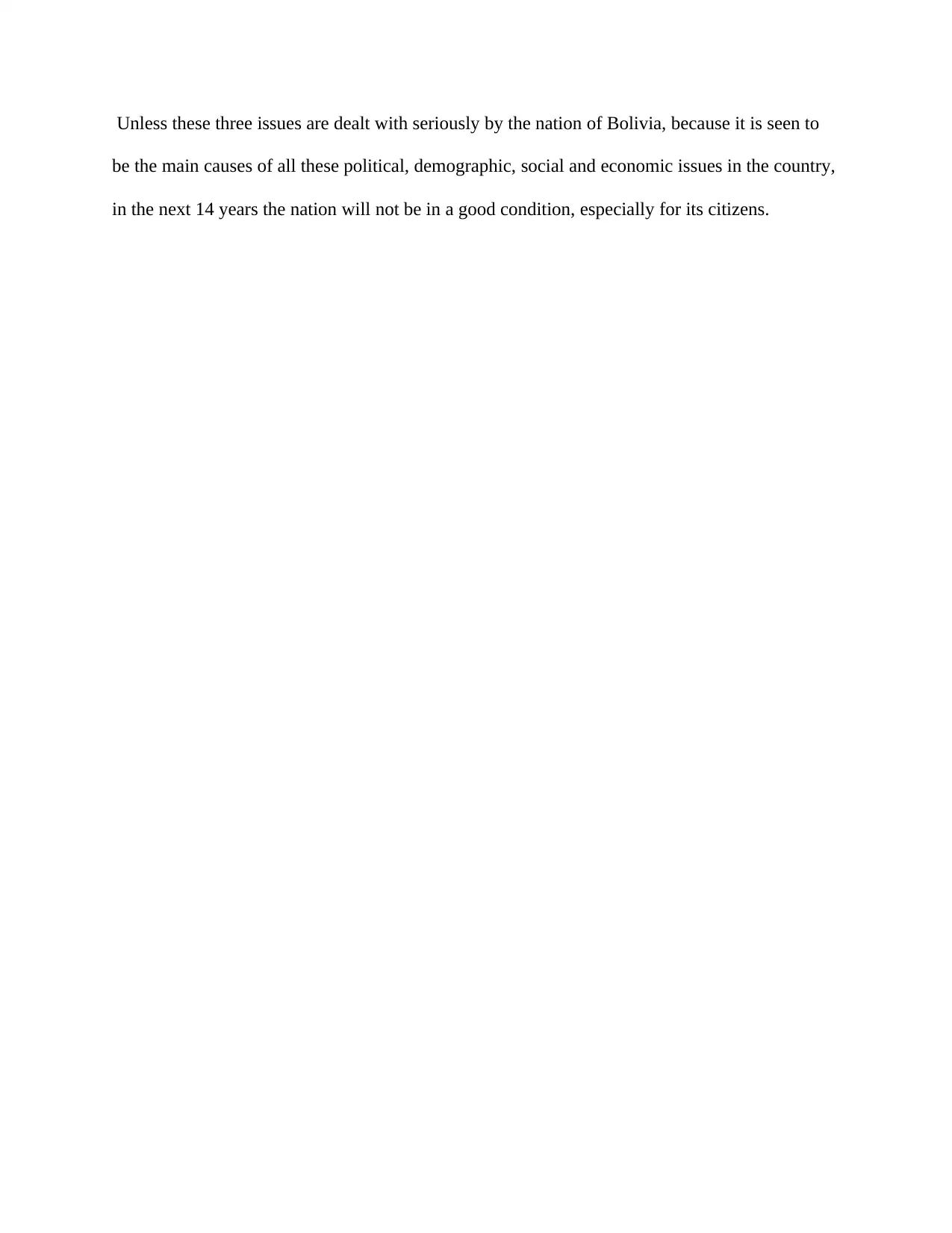
Unless these three issues are dealt with seriously by the nation of Bolivia, because it is seen to
be the main causes of all these political, demographic, social and economic issues in the country,
in the next 14 years the nation will not be in a good condition, especially for its citizens.
be the main causes of all these political, demographic, social and economic issues in the country,
in the next 14 years the nation will not be in a good condition, especially for its citizens.
Paraphrase This Document
Need a fresh take? Get an instant paraphrase of this document with our AI Paraphraser
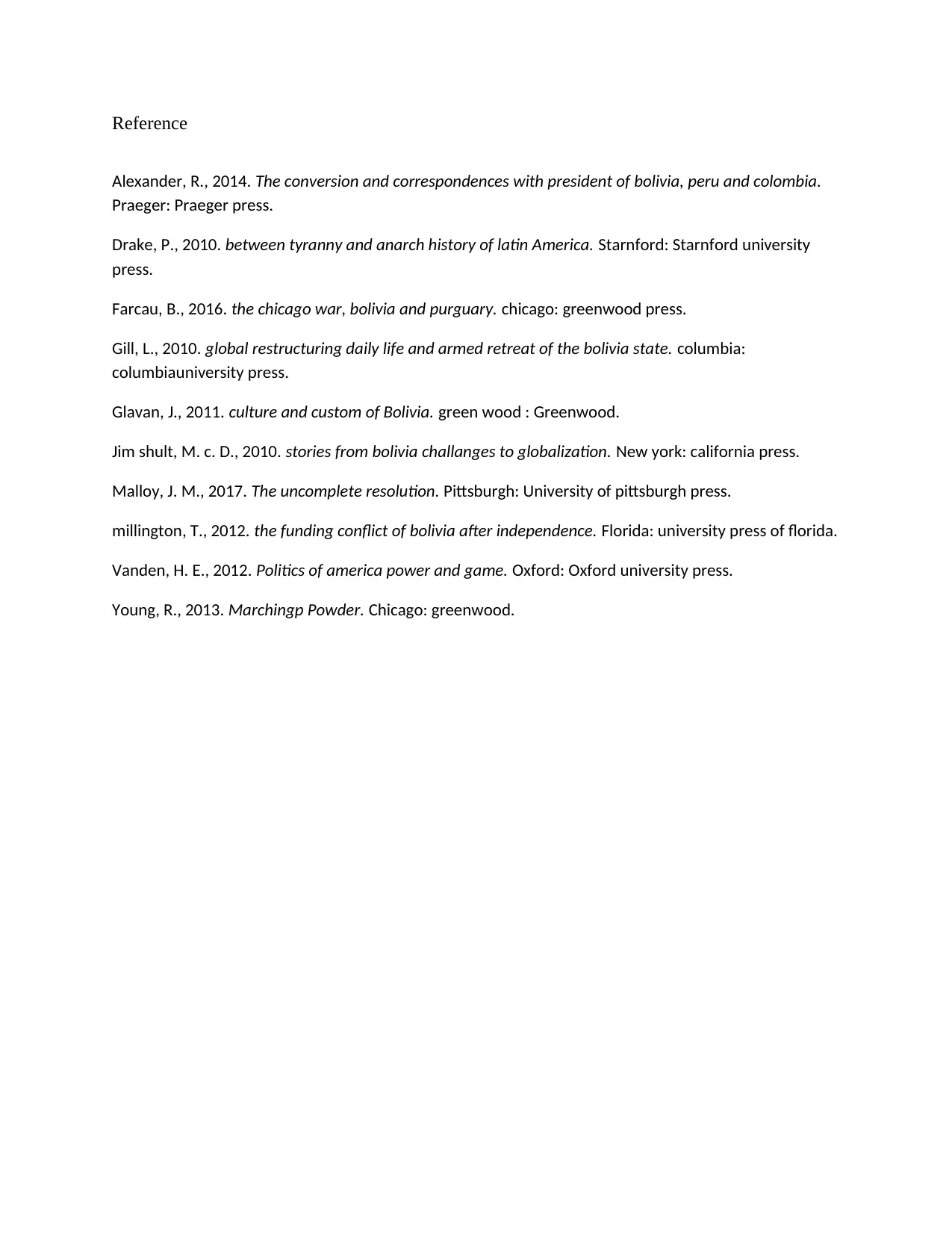
Reference
Alexander, R., 2014. The conversion and correspondences with president of bolivia, peru and colombia.
Praeger: Praeger press.
Drake, P., 2010. between tyranny and anarch history of latin America. Starnford: Starnford university
press.
Farcau, B., 2016. the chicago war, bolivia and purguary. chicago: greenwood press.
Gill, L., 2010. global restructuring daily life and armed retreat of the bolivia state. columbia:
columbiauniversity press.
Glavan, J., 2011. culture and custom of Bolivia. green wood : Greenwood.
Jim shult, M. c. D., 2010. stories from bolivia challanges to globalization. New york: california press.
Malloy, J. M., 2017. The uncomplete resolution. Pittsburgh: University of pittsburgh press.
millington, T., 2012. the funding conflict of bolivia after independence. Florida: university press of florida.
Vanden, H. E., 2012. Politics of america power and game. Oxford: Oxford university press.
Young, R., 2013. Marchingp Powder. Chicago: greenwood.
Alexander, R., 2014. The conversion and correspondences with president of bolivia, peru and colombia.
Praeger: Praeger press.
Drake, P., 2010. between tyranny and anarch history of latin America. Starnford: Starnford university
press.
Farcau, B., 2016. the chicago war, bolivia and purguary. chicago: greenwood press.
Gill, L., 2010. global restructuring daily life and armed retreat of the bolivia state. columbia:
columbiauniversity press.
Glavan, J., 2011. culture and custom of Bolivia. green wood : Greenwood.
Jim shult, M. c. D., 2010. stories from bolivia challanges to globalization. New york: california press.
Malloy, J. M., 2017. The uncomplete resolution. Pittsburgh: University of pittsburgh press.
millington, T., 2012. the funding conflict of bolivia after independence. Florida: university press of florida.
Vanden, H. E., 2012. Politics of america power and game. Oxford: Oxford university press.
Young, R., 2013. Marchingp Powder. Chicago: greenwood.
1 out of 8
Your All-in-One AI-Powered Toolkit for Academic Success.
+13062052269
info@desklib.com
Available 24*7 on WhatsApp / Email
![[object Object]](/_next/static/media/star-bottom.7253800d.svg)
Unlock your academic potential
Copyright © 2020–2025 A2Z Services. All Rights Reserved. Developed and managed by ZUCOL.